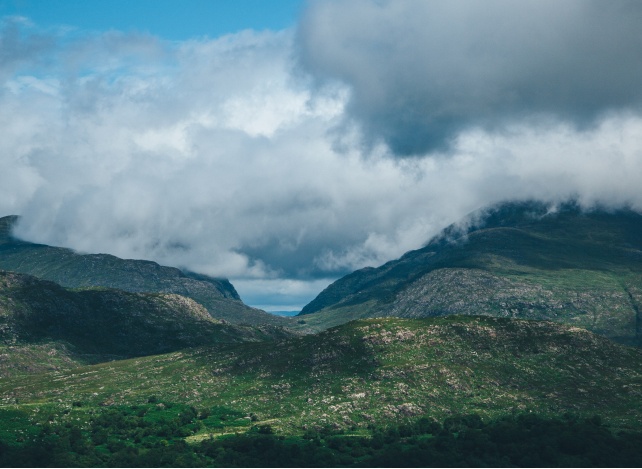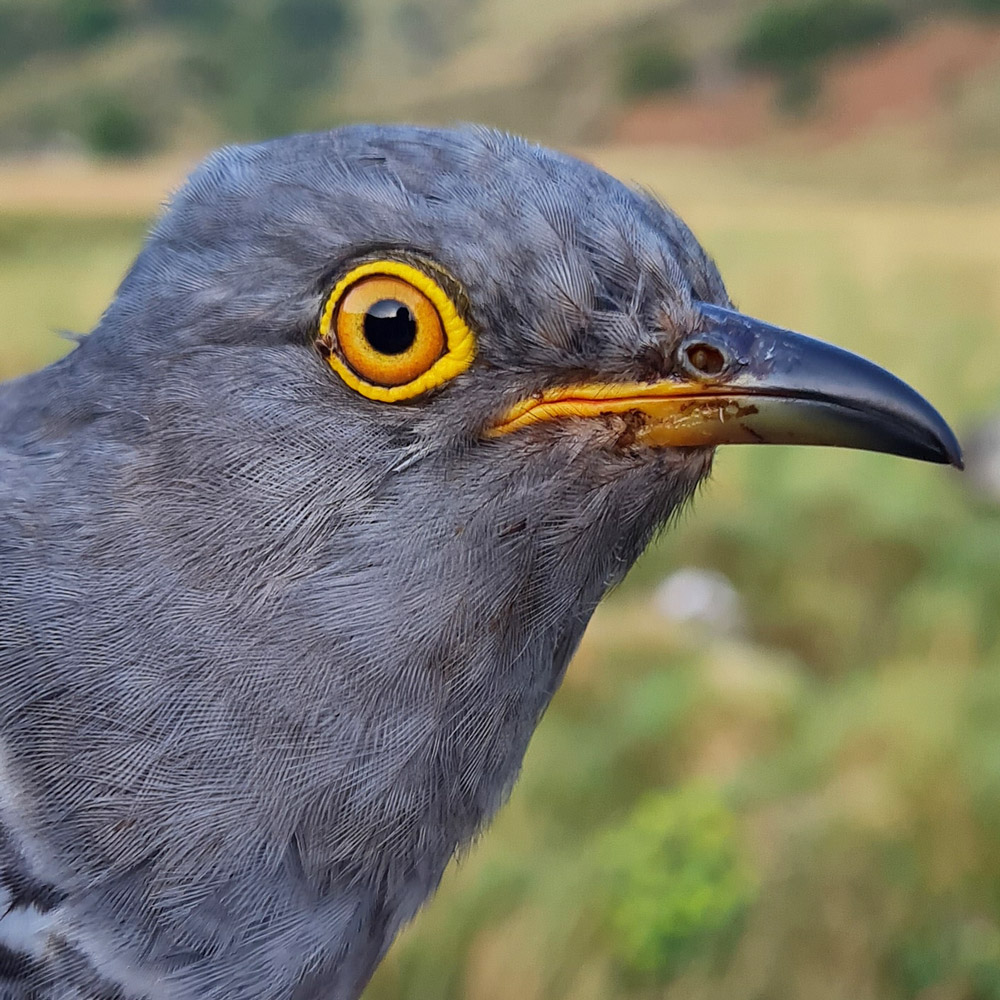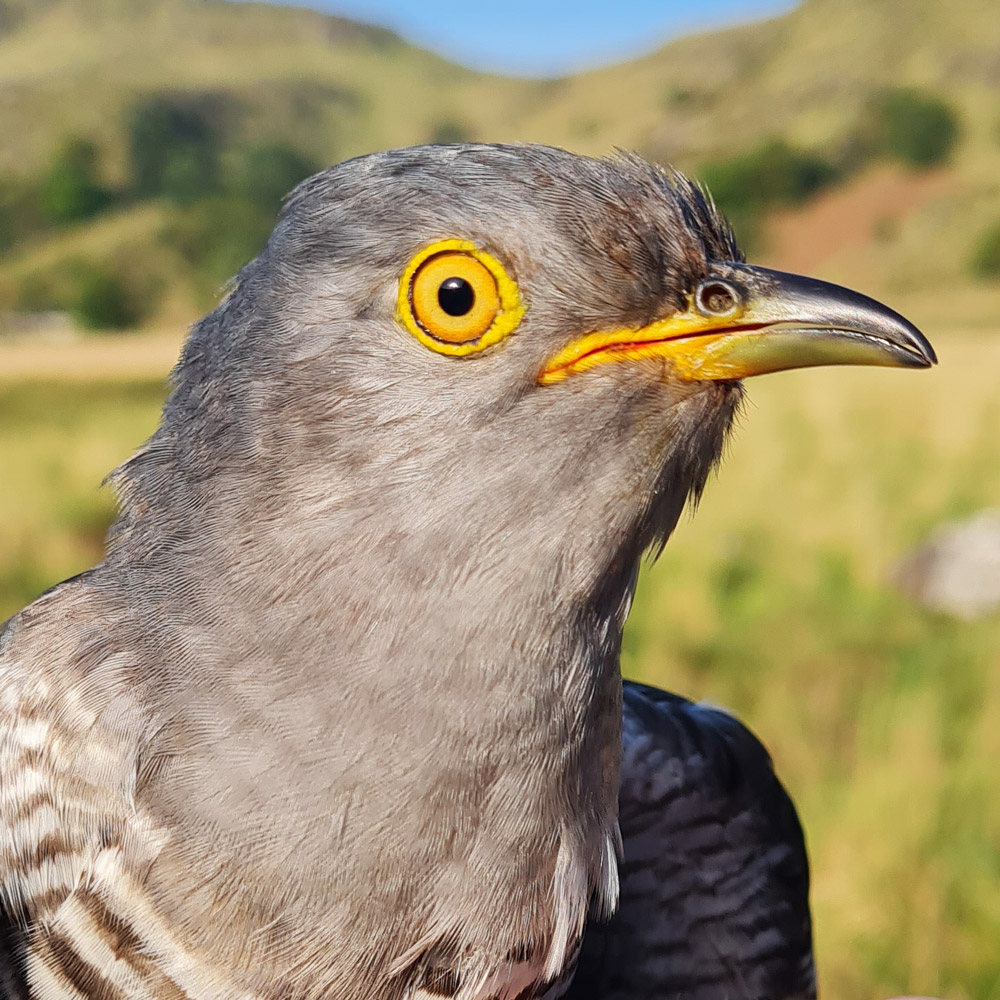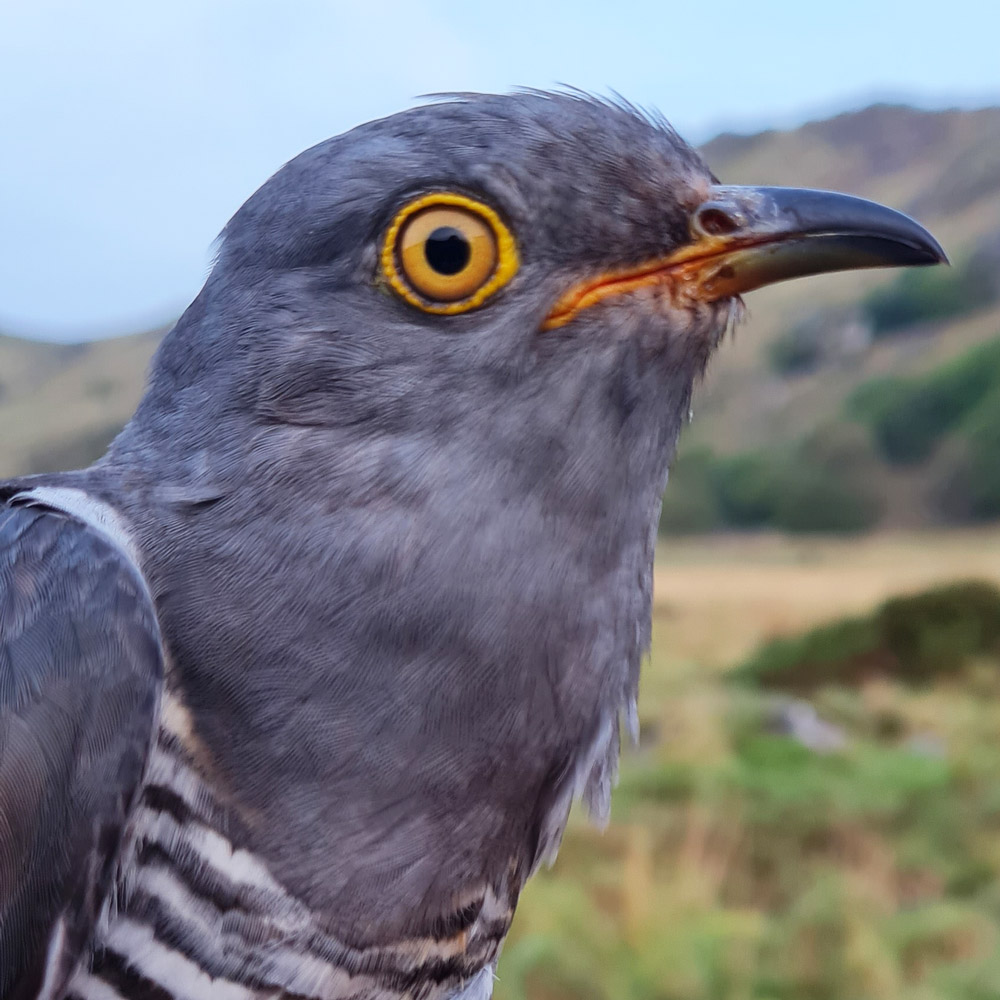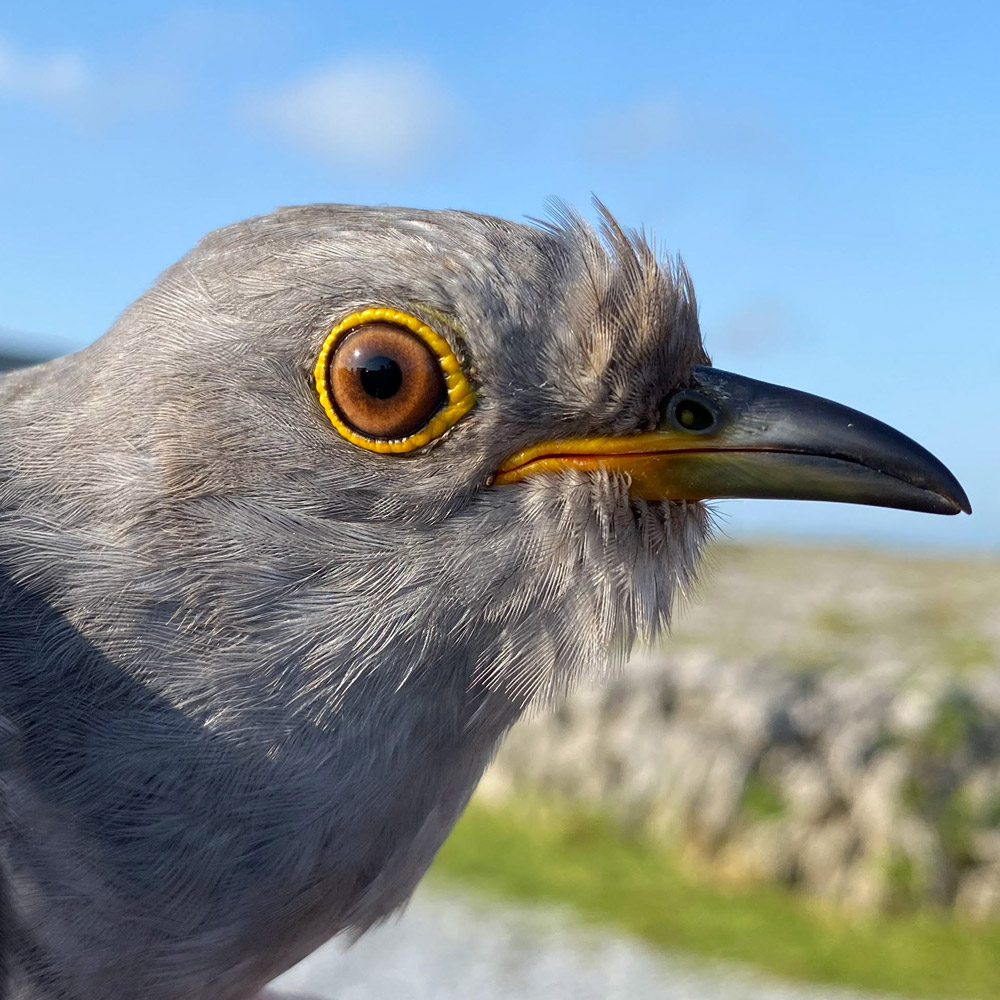Nature & Conservation
Certain parts of Killarney National Park have gone largely undisturbed for several hundred years, allowing a variety of flora and native fauna to thrive. The National Park has been designated a biosphere reserve because of the presence of such rare flora.
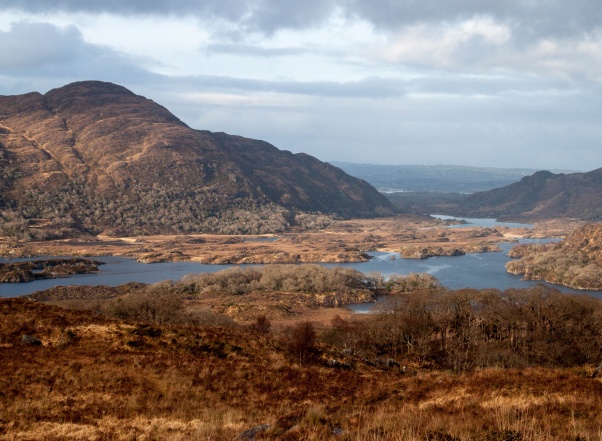
ABOVE: Killarney Lakes at Killarney National Park
Some other noteworthy habitats and species are the indigenous red deer herd and the Reenadinna yew woodland.
The red deer in Killarney National Park are the last surviving indigenous herd of red deer in Ireland. The Killarney herd has been here since Neolithic times. All other red deer herds in the country are descended from re-introduced stock.
The Reenadinna Woods is the largest area of yew woodland in Western Europe and is designated as a Special Area of Conservation. Trees within it are estimated to be between 200 and 250 years old.
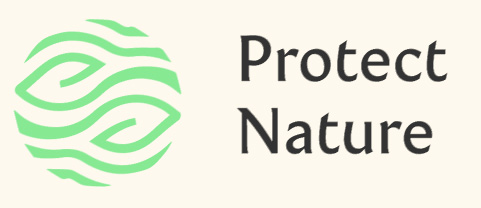
Thank you for helping us protect nature at Killarney National Park. When you enjoy responsible outdoor recreation here, you help us preserve the unique creatures and habitats of the Killarney wilderness.
Conservation Projects & Rare Breeds
Conservation: Irish Cuckoo Tracking Project
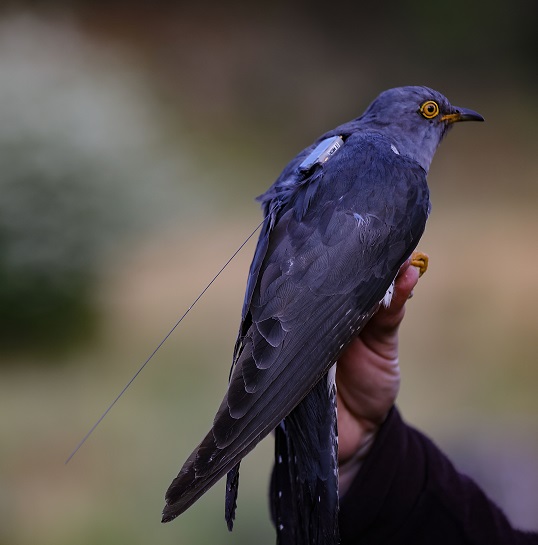
ABOVE: Cuach Carran being tagged.
Conservation: Irish Cuckoo Tracking Project
The Cuckoo or Cuach
The Cuckoo, along with the Swallow and the Corncrake, has a long Irish history as a harbinger of summer, arriving in the last days of April which have often been referred to as ‘the time of the cuckoo.’
Cuckoos are a summer migrant to Ireland with adult birds only being here from April to early July having spent the winter in Africa and are a unique bird in Ireland as they lay their eggs in other birds’ nests and have no involvement in raising their young.
The Cuckoo has seen a 27% contraction in breeding distribution between the first national census, Bird Atlas (1968-1972), and the most recent Bird Atlas (2007-2011). In the most recent Bird Atlas population trends across Britain and Ireland show large declines across England and Wales, increases in Scotland and relative stability in Ireland. Thus, Cuckoo shows a population shift northwards and westwards similar to a number of other migrants which winter in Africa’s humid regions. However, there is little known about the potential causes and drivers of these declines.
Tracking Cuckoos
In 2011, British Trust for Ornithology (BTO) embarked on a new project to study Cuckoo migration patterns. Whilst the Cuckoo had been well studied during the breeding season in the UK, once they head off on migration very little was known about the routes they take or where in Africa they spent the winter months. If the areas of importance for these birds could be identified, then they could study pressures there which could explain the losses of the Cuckoo population.
As of the end of 2022, over 100 adult Cuckoos have been tagged across Britain and a lot has been learned about the routes taken, and some of the pressures they face whilst on migration. But the big question for us is do Irish Cuckoos face the same issues or do they undertake a different migration strategy and different challenges?
So in May 2023, NPWS linked up with the BTO Cuckoo team to satellite track four Irish Cuckoos. Three from Killarney National Park, Co. Kerry and one from Burren National Park, Co. Clare. Three of these birds were sponsored directly by NPWS whilst the fourth was by a private sponsor. These birds were fitted with satellite tags and their movements can be followed on the links below:

Conservation: Indigenous Red Deer Herd
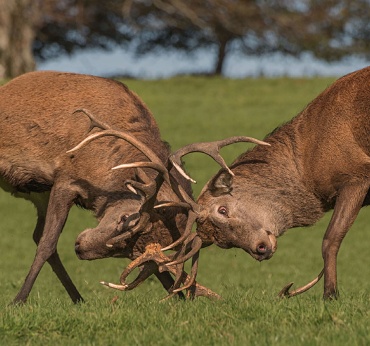
ABOVE: red deer stags
Conservation: Indigenous Red Deer Herd
The red deer herd found in the National Park dates back to Neolithic times and is now the only surviving indigenous herd left in the country. While herds of red deer can be found elsewhere in Ireland, they are from re-introduced stock (mainly from Scotland).
The red deer is Ireland’s largest land mammal and the stags can achieve a weight of 220kg. The female, or hind, can reach up to 110kg in weight. As the name suggests, they have a deep reddish brown coat that turns brown-grey in colour in winter as it thickens for protection against the weather. Red deer are primarily grazing animals but also included in their diet is heather, small shrubs and rough grasses. The stags shed and regrow their antlers every year, ensuring they are in tip top condition for the rut.

Rare Species: Native Kerry Cattle Herd
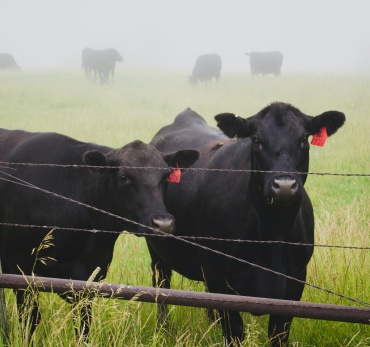
ABOVE: kerry cattle
Rare Species: Native Kerry Cattle Herd
A native herd of Kerry cattle can often be seen grazing in the Killarney National Park. Now considered a rare breed, they are easily identifiable because of their colour and size.
Kerry cattle are almost entirely black except for an odd small patch of white on their udders. Males can weigh up to 550kg and the female between 350 – 450kg and while they are smaller than other breeds, they are still robust and strong. They are believed to be one of the oldest breeds of cattle in Europe and were primarily used for milk production. There are very few Kerry cattle left but herds can be found in Ireland, the UK, Canada and America.

Conservation: Eagle Reintroduction Programme
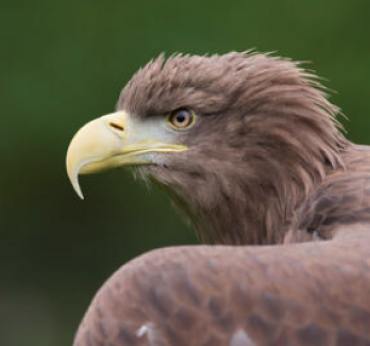
ABOVE: white-tailed sea eagle
Conservation: Eagle Reintroduction Programme
White-tailed sea eagle (Haliaeetus albicilla) – eagles hadn’t been seen in Ireland since the early 20th century until a reintroduction programme in the Killarney National Park, and now there are white-tailed sea eagles in the sky once more.
One of Ireland’s largest resident birds, the eagle has a wingspan of up to 2.4 metres and a body length of approximately one metre. The female is the larger of the two and can weigh around 6kg whereas her male counterpart weighs around 4kg. An adult eagle is brown in colour with a pale head and their distinctive white tail appears when they are around 3-4 years. Many sightings of the eagle within the National Park have been over Lough Leane.
More facts and and videos from the live webcam recordings on the White-tailed Sea Eagle are available from the Glengarriff Nature Reserve website.

Rare Species: Killarney Shad of Lough Leane
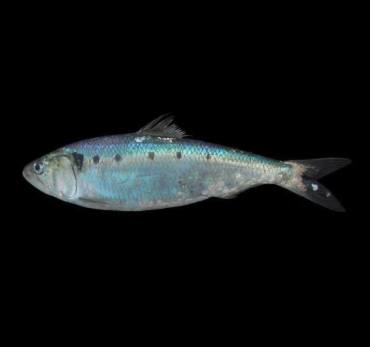
ABOVE: Killarney shad
Rare Species: Killarney Shad of Lough Leane
Killarney shad (Alosa killarnensis) – known locally as a ‘goureen’ the Killarney shad is not only unique to Ireland, it is unique to Kerry and specifically one particular lake within the Killarney National Park, Lough Leane.
Growing up to 20cm in length and with a herring-like appearance, the shad has a life expectancy of five years. They feed mainly on zooplankton found in the lake. The female is slightly larger than the male and chooses gravel areas near the islands on the lake to spawn during June and July. This is a particularly interesting species as it is believed to have arrived in the lake at the time of the last glacial period maximum 10,000 years ago, and as the ice sheets melted it had to adapt to become a landlocked species.

Rare Species: Caddisfly (Setodes argentipunctellus)
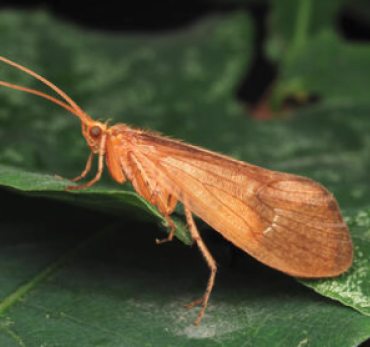
ABOVE: caddisfly
Rare Species: Caddisfly (Setodes argentipunctellus)
This particular caddisfly is a rare aquatic insect in Ireland found only in Killarney National Park. It is believed to be a survivor of the last ice age.
Despite the name, it is not a fly; whereas a fly has only one pair of wings, a caddisfly has two pairs. Found around lakes, rivers and streams, caddisfly larvae are aquatic. The lifespan of an adult caddisfly is only a few weeks. Caddisfly adults and larvae are an important food source for fish and birds.

Rare Species: Northern Emerald Dragonfly (Somatochlora arctica)
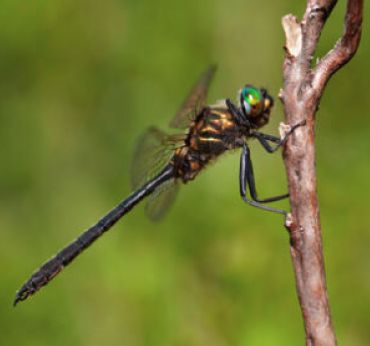
ABOVE: northern emerald dragonfly
Rare Species: Northern Emerald Dragonfly (Somatochlora arctica)
This is Ireland’s rarest dragonfly, now believed to be restricted to two small areas within Killarney National Park. The adult northern emerald dragonfly lives only a short time, typically between one to eight weeks.
During that time they can be found either near the ground where they hang on vegetation, or foraging high in the treetops. They can be seen between May and September but are more likely to be spotted in June and July. The female deposits her larvae in shallow bog pools and their tiny eggs can be found on branches and leaves of aquatic plants or in water or wet mud. The population of the northern emerald dragonfly in Ireland is believed to be less than 1,000 adults.

Flora
Certain parts of Killarney National Park have gone largely undisturbed for several hundred years. This has allowed a variety of species of flowers and plants to thrive. Some of the plants found in the National Park are unique in Ireland. The National Park has been designated a biosphere reserve because of the presence of such rare species.
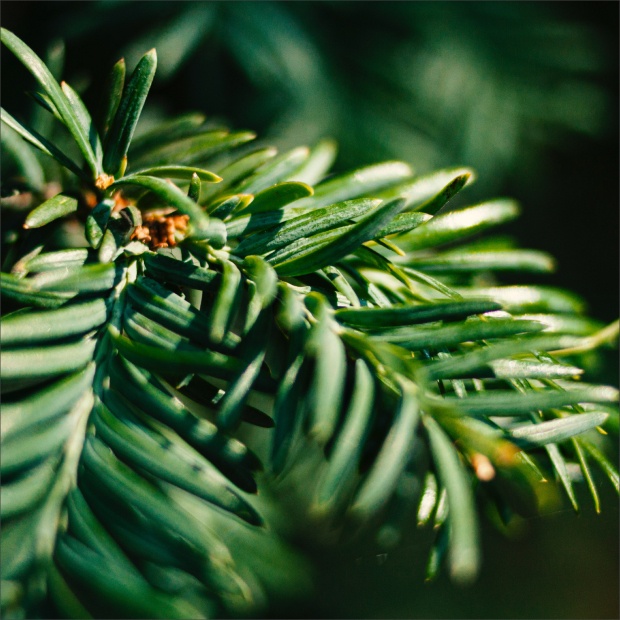
ABOVE: Yew tree
Protected & Rare Flora
Two saxifrages, St. Patrick’s cabbage (Saxifraga spathularis) and kidney saxifrage (Saxifraga hirsuta), both frequent in the National Park, are found in western Ireland and northern Spain and Portugal.
Saxifraga spathularis, the St Patrick’s cabbage, is a species of saxifrage native to Ireland, Portugal, and Spain. It is a member of the so-called Lusitanian flora, a small set of plants which are native to Ireland but inexplicably absent from Great Britain. It consists of a basal rosette of elongate obovate succulent leaves around an upright leafless flowering stem. It seems to grow best in humus-rich alpine habitats among acidic rocks.
Sources: Wikipedia
Kidney Saxifrage is a mat-forming, evergreen perennial with rosettes of fleshy, hairy, toothed, kidney-shaped, dark green leaves and loose panicles of star-shaped, white flowers in late spring and early summer.
A perennial, stoloniferous herb, found growing only in damp, shaded places, such as woods, north-facing cliffs and banks, and by streams and on rocks in the mountains. Naturalised populations in Britain, often derived from garden escapes, are often found on limestone, whereas in its native Ireland the species occurs only on siliceous rock.
Sources: Shoot Gardening, Biological Records Centre – Plant Atlas
Greater Butterwort, or Bog Violet, is a larger plant than Common Butterwort; even so it is a small perennial. The flower makes many botanists consider it to be the most beautiful of the Irish flora; it is a rich violet colour.
Like Common Butterwort this plant is insectivorous, the sticky, yellowish leaves rolling inwards to trap and digest insects. Similarly it grows in bogs, damp clearings in woods, wet heaths and rocks. Unlike Common Butterwort it only grows in a limited area: Cork and Kerry, where it is prolific, and Limerick and Clare, where it is rare. It can be cultivated in an Alpine house or as a garden plant in acid, boggy soil.
The flowers appear in May and June.
Sources: Ireland’s Eye
Blue-eyed grass is a small, tufted perennial of wet pastures, lake shores and grass verges that is widespread in North America and has its European presence principally in Ireland.
Sisyrinchium bermudiana was given its scientific name at a time when botanists quite wrongly believed it was confined to Bermuda.
The plant prefers consistently moist soils which at the same time provide good drainage. It is therefore most often found on damp shingle, gravelly or sandy soils which are poor to moderately fertile, and neutral to slightly alkaline in reaction.
The small, pale blue flowers only open on bright, sunny, mid-summer days, which means that the species is very easily overlooked.
Sources: Habitas
Mountain sorrel is a perennial plant with a tough taproot that grows to a height of 10 to 30 cm. It grows in dense tufts, with stems that are usually unbranched and hairless. Both flowering stems and leaf stalks are somewhat reddish. The leaves are kidney-shaped, somewhat fleshy, on stalks from the basal part of the stem. Flowers are small, green and later reddish, and are grouped in an open upright cluster. The fruit is a small nut, encircled by a broad wing which finally turns red. Forming dense, red tufts, the plant is easily recognised.
The leaves of mountain sorrel have a sour or fresh acidic taste and are rich in vitamin C. They can be eaten raw or cooked.
Sources: Wikipedia
Asplenium viride is a species of fern known as the green spleenwort because of its green stipes and rachides.This feature easily distinguishes it from the very similar-looking maidenhair spleenwort, Asplenium trichomanes.
Green spleenwort is a native species of northern and western North America and northern Europe and Asia. It is a small rock fern, and grows on calcareous rock.
Sources: Wikipedia
Diphasiastrum alpinum, the alpine clubmoss, is a species of clubmoss. It was first described by Carl Linnaeus in his Flora Lapponica, 1737, from specimens obtained in Finland. It has a circumpolar distribution across much of the northern parts of the Northern Hemisphere: much of Canada, the northwestern United States, northern and central Europe, Russia, China and Japan.
Diphasiastrum alpinum grows 10–20 cm tall from stems which grow just under the surface of the ground. The leaves are hollow at the base.
Sources: Wikipedia
Saxifraga rosacea, or Irish saxifrage, is a herbaceous plant in the family Saxifragaceae. It spreads by stolons, forming a compact cushion of short leafy shoots. Flowering stems may be up to 25cm tall, bearing 4-5 white flowers with petals 6-10mm long.
It is found in the west of the British Isles, and in Iceland. It became extinct in England in 1960. It is usually found by mountain streams, but also grows on cliffs and scree slopes.
Sources: Wikipedia
The Killarney fern is noteworthy for its rarity in Ireland and is listed under the Flora Protection Order (1999). The Killarney fern was formerly widespread around Killarney, but was severely depleted in the 19th century by commercial collection and sale of living specimens associated with the Victorian craze for ferns. As a result only a few populations now survive in the Killarney district.
Killarney fern is a medium-sized, long-lived fern with delicate, highly divided fronds. This species likes humid, dark, sheltered sites beside waterfalls, in rock crevices and under over-hanging rocks. This vulnerable and very rare species is protected in Ireland. It is one of only three European species with translucent leaves and requires a humid, frost-free environment.
Sources: Wikipedia
Pillwort is a very distinctive little grass-like plant. It is an aquatic fern with thin, thread-like leaves which unfurl from tight coils as it grows. It has hard spore cases ‘the pills’ at the base of the stems. In the right conditions it forms a creeping mat over bare mud at the margins of ponds and lakes which make it look like a miniature bright green lawn.
It is native to western Europe, where it grows at the edges of lakes, ponds, ditches and marshes, on wet clay or clay-sand soil, sometimes in water up to 30 cm deep.
Sources: Freshwater Habitats Trust, Wikipedia
Betonica officinalis, commonly known as common hedgenettle, betony, purple betony, wood betony, bishopwort, or bishop’s wort, is a species of flowering plant in the mint family Lamiaceae, native to Europe, western Asia, and northern Africa.
Its leaves are stalked on upright stems, narrowly oval, with a heart-shaped base, with a somewhat wrinkled texture and toothed margins. Bright purple to red flowers appear throughout the summer and into early autumn.
Sources: Wikipedia
This native plant from the Asteraceae family, is a rare species which grows in dry, infertile, open, sandy or gravelly areas.
It is formed of clusters of 3-6 flowerheads, each cluster measuring 5-8mm in width. It has wide-spaced, narrow greyish leaves covered with white-woolly hairs. Slender cudweed is a small plant growing to approximately 5–15cm.
Most recent records are from Northern Ireland, but it is also recorded in east and southeast Ireland.
It flowers from June – September.
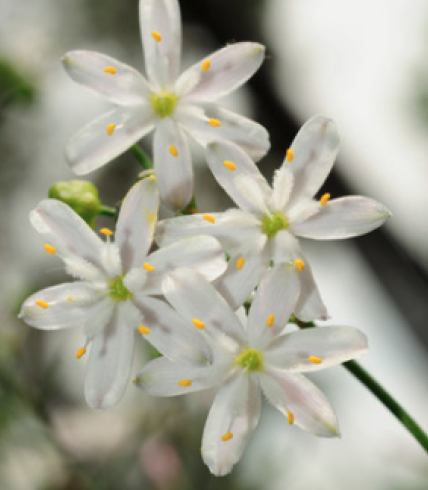
Wildflowers
Wildflowers are flowers that grow freely in the wild and they are an important part of protecting biodiversity. In Ireland we have over 800 flowering plants. Wildflowers are under threat from agricultural practices, invasive species and the rezoning of land for building purposes. Approximately 120 species of wildflowers are under threat in Ireland.
Species found in the National Park include: asteraceae, bluebell, common honeysuckle, bitter vetch, lesser celandine, ragwort, slender rush, thistle, mouse-ear chickweed, knapweed, hawkweed, wood sorrel, enchanter’s nightshade, bog asphodel, common butterwort and round-leaved sundew. The Kerry lily is a rare and protected species found in the National Park.
Fauna
Although Ireland has a low number of animal species compared to the rest of Europe, many of our species and habitats are of international importance. Killarney National Park is home to several species that are unique not only to Ireland but to the National Park itself.
There is an incredible diversity in the species of birds found in the National Park; some are resident, whilst others are migratory and spend only part of the year here. There is in excess of 450 bird species in Ireland and of those over 140 have been recorded in the National Park.
There are 26 species of terrestrial mammal native to Ireland and 20 of these can be found in Killarney National Park. Terrestrial mammals are animals that live on land, are warm blooded and give birth to live young (rather than laying eggs). They breath air and at some point in their lives will have hair.
Invertebrates are the most diverse and numerous group of animals on Earth. An invertebrate is a cold-blooded animal with no backbone. They can live on land, like insects, spiders, and worms or in water, like mussels and aquatic snails.
Amphibians and reptiles have a backbone but unlike other vertebrates, such as mammals and birds, the majority of the species are cold-blooded. In Ireland there are only two native species of amphibians and one native species of reptile. All three can be found in the National Park.
Fish are aquatic vertebrate animals that have gills but lack limbs and can be found in virtually all aquatic habitat. There are 14 different species of fish in the waters of Killarney National Park, one of which is particularly rare and found nowhere else in the world.
Bird Species
An adult White-tailed Sea Eagle (Haliaeetus albicilla) is brown with a pale head and a distinctive white tail. It is the largest bird of prey in Ireland with a wingspan of up to 2.4m. Females are about a third larger than the males, weighing around 6kg compared to an average male of around 4kg. Juveniles are darker brown than the adults and do not develop a white tail until 3-4 years of age. White-tailed eagles can live for over twenty years.
Sources: Glengarriff Nature Reserve
Barn owls are a scarce resident, mainly present in central and southern Ireland. They no longer breed in large patches of northern, western and eastern Ireland. They have been red-listed in Ireland due to a significant decline in the breeding population. The European population is currently evaluated as ‘Declining’.
Barn owls are rarely seen during the day and are only active late at night. Most frequently they can be seen flying across roads in car headlights. They appear ghostly white, with no markings on the underwing, but on closer view they show a remarkably intricate patterning on the wings, back and head.
Sources: Birdwatch Ireland
Kingfishers are resident on Irish streams, rivers and canals. They have a very distinctive, brightly coloured plumage. The underparts are a bright orange-red, while the wings and back of the head are dark blue. The back, rump and tail are a bright, almost “electric” blue and usually draw attention to a flying bird.
Despite these bright colours, kingfishers can be easily overlooked, perched motionless on a branch beside a stream or river on the look-out for fish. During the breeding season, females have a small red patch at the base of the bill, which is not shown by adult males.
Its call is a shrill whistled “chee-kee”, frequently repeated. It is usually one of the first signs that a kingfisher is present along a stream or river.
Sources: Birdwatch Ireland
Mammal Species
Red deer (Cervus elaphus) is the largest land mammal in Ireland. In Killarney, the indigenous red deer provide one of the highlights of the year for visitors to the National Park, the red deer rut. The male deer, or stags, start to distance themselves from one another from August onwards until October when the rut starts. Lasting for a number of weeks, the males will defend their area with a great show of strength. Starting with a vocal warning known as bellowing, the rival males will parallel walk before finally locking their antlers to determine the strongest and most dominant male. Quite often a rival stag will back away before it comes to the final joust because pursuing the fight can lead to serious injury for the weaker male. It is an impressive sight, but visitors should be cautious and keep their distance.
Listed as ‘near threatened’ on a global list, the otter is an elusive animal that can be found in a diverse range of aquatic habitats including streams, rivers, upland lakes and even coastal lagoons. Otters are nocturnal and are spotted either at dawn or dusk. They have long streamlined bodies with short legs, webbed feet and a thick, muscular tail. Their fur is dark brown and made up of two distinct layers that helps keep them dry and warm. When swimming underwater, the otter can close its nostrils and ears. Their diet consists of various fish, sticklebacks, salmonids, frogs, eels and crayfish.
The Irish hare is not only a native species, it is unique to Ireland and has been present here for approximately 12,000 years. Although a relative of the mountain hare, the Irish hare does not turn white in winter but instead goes from a reddish-brown colour in summer to a greyer colour in winter. Often mistaken for a brown hare, the Irish hare is a little smaller and has a white tail rather than a black stripe like the brown hare. The females are larger than their male counterparts and are the more dominant of the two; they can often be seen ‘boxing’ with a male during the breeding season. They feed mainly on grasses but during winter will forage on a variety of plant species.
Other Fauna Species
Found in only Kerry, West Cork, Spain and Portugal, the Kerry slug can live for up to seven years and grows between 6-9cm in length. It is either black/grey with white flecks or brown with cream flecks. Found in woodland locations, it feeds on lichens, moss, fungi and liverworts growing on sandstone boulders. It’s called the Kerry slug because the first specimen to be observed was found in Kerry in 1842.
A critically endangered species, the Freshwater pearl mussel is now very rare in the world. There are eight locations in Ireland where it is found, one of which is on the boundary of the National Park. The mussel is found in rivers rather than lakes and needs clean, oxygenated, low-nutrient water. It is one of Ireland’s longest living animals and can live to over 100 years. It grows to between 12-15cms and, as an adult, can filter up to 50 litres of water a day.
Although it can be found in various parts of Ireland, the marsh fritillary is still protected under Annex II of the European Union Habitats and Species Directive because of potential habitat loss. As the name suggests, the marsh fritillary likes wet or marshy ground and relies on the broad leaves of the devil’s bit scabious plant for its lifecycle. The cycle from larvae to adult butterfly takes a year to complete, but life as an adult butterfly is only two to three weeks.
Ireland’s only native reptile is versatile in its habitat and can be found in woodlands, marshes, heaths and bogs. Ranging in length from 10 to 16 cm, they have long bodies, short legs and a long tapering tail that, when trapped by predators, can be shed to aid escape. The tail will then grow back. The common lizard has a lifespan that can reach up to five years and its diet consists of slugs, snails, earthworms and a variety of insects. Although most reptiles are known for laying eggs, the viviparous lizard gives birth to live young that have been hatched from eggs kept inside the female.
Otherwise known as the common newt, it is native to Ireland and can be found in woodlands, hedgerows, marshes and areas dominated by tussock grassland. They can grow between 7 to 11 cm and have an average lifespan of six years. Their diets consist of caterpillars, slugs, worms and insects on land but when in water they will eat crustaceans, molluscs and tadpoles. They are the only amphibian found in Ireland that has a tail and all too often they get mistaken for newts. An easy way to tell them apart is to look at their skin; a smooth newt (as the name suggests) has a smooth skin whilst a lizard, being a reptile, is scaly.
This particular salmon is native to Ireland and is found in most of our rivers. Salmon can grow up to 75 cm in length and weigh up to 5.5kg. Their diet varies according to their habitat and while a young salmon will feed on the larvae of aquatic insects and other aquatic invertebrates in freshwater, adult salmon confine themselves to feeding out at sea on small fish such as herring and sprats. Salmon are a symbolic species in Ireland, providing an economic benefit from angling tourism and they form part of the Fenian cycle in Irish mythology in the story of the Salmon of Knowledge.
Habitats
The National Park has a wide diversity of habitats including woodlands, lakes, rivers and ponds, waterfalls, bogs and heath, grassland and rock.
Yew Woodland
Woodland dominated by yew covers some 25 ha of Carboniferous limestone reef and pavement in Reenadinna Wood on the Muckross Peninsula. In addition to yew, hazel, oak, ash, holly, alder and willow are locally common where soil-filled hollows are present. Reenadinna Wood is the only significant stand of yew woodland in Ireland and indeed Western Europe. The limestone outcrops are largely enveloped by a thick blanket of bryophytes which is notable for the presence of the southern Atlantic liverwort Marchesinia mackaii.
Wet Broadleaved Woodland
This category includes woodlands that are flooded in winter, but dry out in summer as well as woodlands that are permanently waterlogged. The former occurs on low-lying Carboniferous limestone areas at lake edges, most notably along the north-eastern side of Lough Leane (e.g. at Reen and on Ross Island). Most of this area is flooded during the winter with little or no standing water present during the summer. However, the surface soil remains wet or very damp.
Blanket Bog
Bog occurring on deep, flat areas of peat in lowland areas is characterised by bog moss hummocks separated by pools, and has some features in common with the vegetation of midland raised bogs. Looscaunagh, Newfoundland and Oak Island Bogs can be described in this category. Blanket bogs at higher altitudes typically support species such as ling heather, crowberry, bilberry, cotton-grass and heath rush, along with a variety of bog mosses and distinctive lichens.
Dry Broadleaved Woodland
The oak woodlands on Old Red Sandstone in Killarney constitute the most extensive remaining area of native woodland in Ireland. These woodlands range from relatively extensive lakeside tracts, such as Tomies Wood to more fragmented high valley woodlands such as Upper Doogary and Glaisín na Marbh. In well-developed woodland, the canopy is almost exclusively sessile oak, usually between 13 and 20 m high, with an open under-storey of holly. Birch and rowan are also frequent, but rarely form pure stands.
Heath
Wet heaths are botanically similar to blanket bogs. They can occur on varied types of terrain, but are best represented on moderately steep, badly drained moraine slopes, where the peat is rarely much more than one metre deep. Typical species include ling heather, cross-leaved heath, gorse and bog myrtle, with purple moor-grass, deer-grass, cotton-grass, tormentil, heath rush and some bog moss species. The best developed dry heath in the National Park occurs on the mountain slopes immediately west of Lough Leane, such as Shehy, Tomies and Purple Mountains.
Mixed Woodland
Some woods in or near the demesnes of the two estates display many features of natural woodlands, but also have numerous exotic species in them. These woods include the Game Wood, remnants of Bellview Wood, parts of Ross Island and Reen, as well as the Monks Wood and other parts of Muckross. Some exotic trees and shrubs including beech, hornbeam, sycamore, rhododendron, cherry-laurel and Portugese laurel regenerate freely, in some cases from seed and in others vegetatively.
Grassland
Grassland types within the National Park range from unimproved species-rich grasslands to intensively managed swards around areas heavily used by visitors. Damp meadows with purple moor-grass, found to the east of Lough Leane, support scarce species such as whorled caraway and ivy-leaved bellflower. Other species include sharp-flowered rush, jointed rush, carnation sedge, devils-bit scabious, creeping bent, tormentil, marsh violet and many-headed woodrush.
Rivers, Streams and Waterfalls
Numerous small rivers and streams flow into Lough Leane, Muckross Lake and the Upper Lake. The nature of the underlying geology and the climate means that these are subject to flash-flooding. Although generally acidic and low in nutrients, in places these flowing waters support important stands of floating and submerged vegetation and unusual invertebrates.
Lakes, Ponds and Wetlands
Many of the upland lakes are small corrie types, occurring at cliff bases and impounded by glacial moraines. Examples of classic corrie lakes include the Devil’s Punch Bowl on Mangerton and Lough Crincaum on the north of Cromaglan Mountain. The National Park also contains a number of lowland oligotrophic lakes. These are generally larger than the upland ones, with a wider range of plant species present. Good examples include the Upper Lake and Muckross Lake.
Conifer Plantation
There are three main areas within the Bourn Vincent Memorial Park where the former Department of Lands established commercial conifer plantations between 1933 and 1953. 538 ha on the slopes of Torc Mountain/Muckross was allocated for forestry in 1933, 371 ha of Derrycunihy/Looscaunagh in 1958 and 328 ha in Tomies, also in 1958. The principal tree species planted were sitka spruce and lodgepole pine. Other species include Norway spruce, Monterey pine, Scots pine, European larch, silver fir, Douglas fir, hemlock and cedar.
Geology
Killarney National Park includes parts of the MacGillycuddy Reeks and incorporates many mountains within its boundaries. The lakes and rock formations give scenic views of various dimensions.
